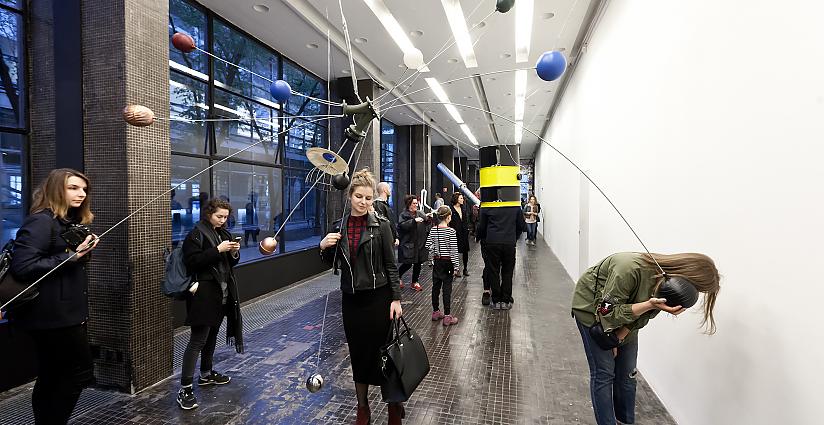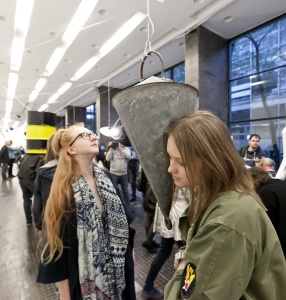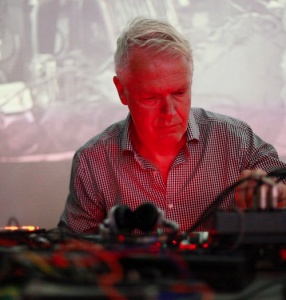Rainforest V
Conceived by David Tudor and realized by Composers Inside Electronics

Initiated in 1968 as a music score to Merce Cunningham’s choreography, ‘Rainforest’ was developed by David Tudor as a work-in-progress. From the beginning its main idea was to bring out the resonant voices of everyday objects. With the use of basic audio technologies (microphones, loudspeakers, amplifiers) normally quiet objects gained a new audible dimension – a voice.
The original objects used were smaller, table-top sized objects that acted as resonant loudspeakers.Tudor developed electronic circuits to stimulate these resonant objects, acoustically transforming the signals sent through them.
A breakthrough came in 1973 when Tudor invited a group of young artists and composers – later to be known as Composers Inside Electronics (CIE) - to collaborate. Among them were John Driscoll and Phil Edelstein. The workshop participants added a new dimension - a performed installation with large objects. In order for the large objects to better resonate they had to be suspended in the air. This element delighted David Tudor and added new visual character to the work. 'Rainforest IV’ evolved as a unique piece of art that revolutionized conceptions about sound installations, performance art and sound art. No equivalent work existed at the time. ‘Rainforest IV’ finally embodied David Tudor’s idea of a rich sonic architecture.
After Tudor's death in 1996, the members of his Composers Inside Electronics collective dedicated themselves to carry on his work with ‘Rainforest’ and other works in order to preserve his pioneering legacy. After numerous performances of ‘Rainforest IV’ they felt it important to expand the concept of Rainforest to include the option to have a self-running installation version. In 2009, Driscoll and Edelstein created an installation version ‘Rainforest V’ and designed additional new objects and sound files along with additional sound files by Matt Rogalsky. ‘Rainforest V’, as a project, blurs the lines between sculptural objects, a constantly evolving immersive sound environment, and a sui generis art form. Its reception depends wholly on one's individual experience and on a trajectory of the audience as they move freely within the installation.
The opening of the 'Rainforest V (variation 2)’ in the Museum of Modern Art in Warsaw will be accompanied by a meeting with John Driscoll and Phil Edelstein from Composers Inside Electronics (CIE) and by performance of a ground breaking multi-channel feedback composition ‘Microphone’ by David Tudor (1970) and ‘Impulsions’ by Phil Edelstein (2015) in the Museum's Auditorium.
1965-66
Tudor works on resonant loudspeakers as part of Bandoneon ! (factorial) which is performed at “9 Evenings of Theatre and Engineering” in 1966.
1968 - RAINFOREST
Tudor is commissioned to create a new work for the Merce Cunningham Dance Company titled “Rainforest”. This work was premiered in Buffalo in March 1968 with Tudor and Gordon Mumma performing the music using 3 to 8 table-top sized amplified objects. This is often referred to as the original “Rainforest” or “Rainforest I”.
The work was part of the Cunningham repertory with a number of revivals until 2011. It was very popular due to its use of helium-filled mylar pillows designed by Andy Warhol as set pieces, costumes by Jasper Johns, and evocative music.
1969-70 – RAINFOREST II
Tudor creates another version of the work using resonant objects with voice input. He is quoted: “In the second version, I wanted to use a vocal input to the system, the natural resonance of the object and its subsequent amplification. It’s a kind of mechanical filter.” (David Tudor Interview with Teddy Hultberg – 1988).
Note: there is currently no record of this version being performed or recorded.
1972 – RAINFOREST III
Tudor created a third version in 1972 that was performed on a European tour with John Cage. He is quoted: “The third version had to deal with the ability to have any input go to any transducer. I made the system for a simultaneous performance with John Cage’s Mureau. It was one of those pieces that changes all the time so I needed to have a sort of continuous things, so I used tape sources, but having the ability to mix them or separate them into different output channels.” (David Tudor Interview with Teddy Hultberg – 1988)
1973 – RAINFOREST IV
Created as part of a Tudor workshop at New Music in New Hampshire in the summer of 1973. Workshop participants were: John Driscoll, Phil Edelstein, Linda Fisher, Greg Kramer, Martin Kalve, Ralph Jones, Susan Palmer, Bill Viola and David Tudor.
In this collaborative version, each of the performers design and construct their own objects and develop appropriate sound sources along with providing the necessary equipment. It was performed by Composers Inside Electronics since 1973 with over 150 performances in 45 venues world-wide. It uses between 12-40 resonant objects.
Note: Rainforest IV was titled “Rainforest” until 1981. Then it was titled “Rainforest IV”.
2009 - RAINFOREST V
This version was created by Composers Inside Electronics (John Driscoll, Phil Edelstein, and Matt Rogalsky) as a self-running installation version. It was premiered at Laboratorio Arte Alameda in Mexico City, Mexico, in 2009, and has also been installed at Governors Island, New York, in 2011.
Note: “Rainforest V” can be installed as a temporary or permanent installation with between 12 to 60 objects.




